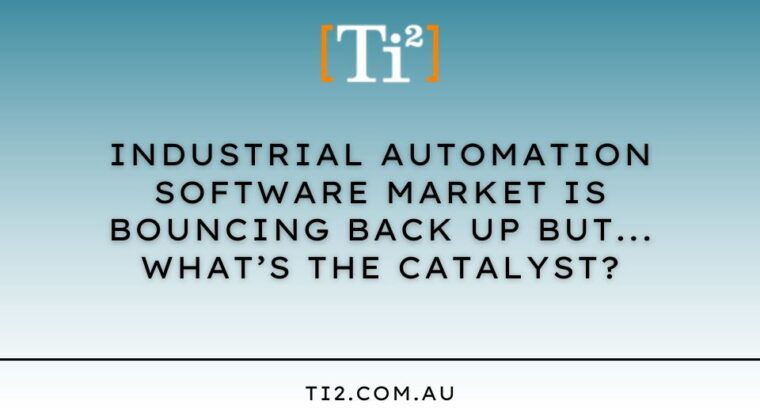
With a projected increase of 67.6%, the market size of the global industrial control & factory automation market is estimated to be AUD 215.3 billion in 2022 and projected to reach AUD 318.3 billion by 2027, at a CAGR of 8.2%. [1]
However what needs to be considered as we continue to move forward is, “What’s The Catalyst?”
With the industrial sector being one of the most dynamic global revolutions, Identifying the factor and variables as to how the market will expand is key for both control and automation companies, as well as manufacturing and industrial.
Several basic influences are as follows:
- Digitalisation
- Rising consumer demand for efficiency and productivity
- The increasing cost of labor
- Focus in sustainability
- Government initiatives
- Adoption of IoT and Ai in industrial environments
Based on market reports [1], China is the major market for industrial control and factory automation in the world, ahead of the United States and Japan, accounting for an estimated amount of 28.7% of global manufacturing output by 2022. [2]
Among others, the major players in the industrial automation market are Emerson Electric Co, General Electric Company, Rockwell Automation Inc., Schneider Electric SE, Siemens AG, Mitsubishi Electric Corporation, ABB Ltd, Dassault Systemes SE, Honeywell International Incorporation, Omron Corporation, Endress+Hauser AG, Yokogawa Electric Corporation, Danaher Corporation, Fuji Electric Co. Ltd., and Hitachi Ltd. [3]
In a nutshell, the industrial automation market comprises the sales of products and services with the purpose of controlling and monitoring a system and/or machine within a plant. This is where the catalysts take place. With various challenges involving logistics, labor, as well as outsourcing difficulties, companies in the industrial and manufacturing industry look at automation to keep processes in-house with the sole purpose of achieving reliability.
Whether it is to predict and determine time, location, and/or processes, automation is inevitable. As human mankind recovers post-COVID, mass manufacturing is still required to fulfill consumer demands. Partnerships and product launches will offer lucrative opportunities for market players in the next five years. [1]
Specifically for the defense, aerospace, transportation, manufacturing, energy, automotive, healthcare, as well as many other industries, the use of industrial automation has evolved to a vast scope including, but not limited to HMI (human-machine interfaces), control valves and motion/other industrial sensors, as well as robots. With HMI, monitoring, maintenance, and operation are made easy, in addition to various control systems such as SCADA, MES, DCS, PLC, PLM, ERP, and others.
According to an Industrial Automation Software Market Report by Technavio, through the lens of Porter’s Five Forces Framework (method to analyse the operating environment of a business competition), as follows are the Five Forces Summary.
Based on the above source, there are three drivers, trends, and challenges that will directly affect the growth of the market.
Drivers:
- Need to reduce overall operational expenses
- Emergence of automation software solutions on cloud
- Increasing plant complexities
Trends:
- Integration of PLM and ERP in industrial automation software
- Increasing need for open platform architecture for automation software
- Horizontal integration by automation solution providers
Challenges:
- Cybersecurity threats
- Interoperability issues due to proprietary software
- Lack of skilled labor
The principle of Industry 4.0, although has been further revolutionised to Industry 5.0, still plays a big role in manufacturing. In oil & gas, food & beverage, chemical, as well as automotive, most process and system needs to be automated 24/7 without human errors. The decrease of production cycle time without compromising quality is their main focus from raw material procurement all the way to final product quality check. These machines and systems are deployed using automation solutions such as the HMI, SCADA, DCS, and PLC. Ti2 offers a range of automation solutions that you can view HERE.
With cyber-physical systems, IoT, and cloud computing, two things are currently playing big in the industry. Robotics and remote big data collection.
The two factors above will create big changes across all sectors of the industries through efficiency, productivity, supply chain management, quality assurance, and workplace safety, all the way to a customer service experience.
We have concluded that the demand and expansion opportunities for control and automation are guaranteed in the short future. Have you considered how it can affect your business?
Ti2 Pty Ltd offers automation products with expertise from world-class suppliers. We provide robust competitive industrial automation solutions helping manufacturing companies among other emerging industries.
To learn more about what we do and how we can help your interoperability requirements, please click projects, products & services.
Ti2 is currently very focused on working with its global partners to secure stock and avoid long delay times in delivering products to their customers. Together with our trusted partners, we are here to provide solutions.
Please click here to email us your inquiry, we would like to hear from you.
